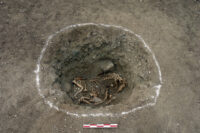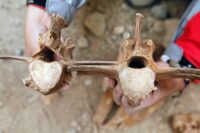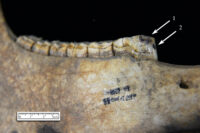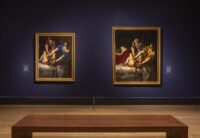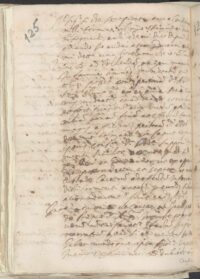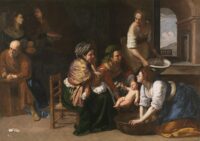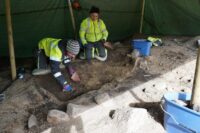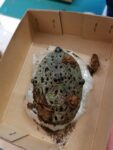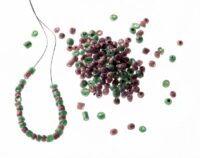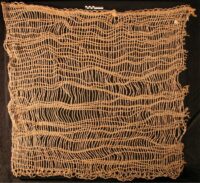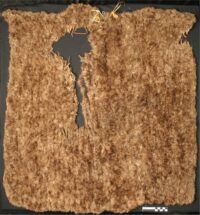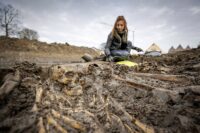 Archaeologists have discovered a mass grave that may date to the late Middle Ages during canal work in Vianen, the Netherlands. The skeletal remains of nine individuals were discovered Friday, and by Monday the team had found another 11. Archaeologists expect to find the remains of more people as they enlarge the excavation area.
Archaeologists have discovered a mass grave that may date to the late Middle Ages during canal work in Vianen, the Netherlands. The skeletal remains of nine individuals were discovered Friday, and by Monday the team had found another 11. Archaeologists expect to find the remains of more people as they enlarge the excavation area.
Preliminary examination of the skeletal remains unearthed so far has found they belonged to young men between 15 and 30 years old. There are no grave goods, no textile fragments, not even a button to give a clue as to the dating and identity of the deceased. Some of the skeletons were stacked and corroded iron nails found at the site indicate some of the bodies were buried in wooden boxes that have disintegrated. Two individuals were laid to rest in one coffin, turned on their sides and in alternating orientation, one with feet pointing north, the other with feet pointing south. They haven’t been dated yet, but archaeologists believe the mass grave dates to the Late Middle Ages.
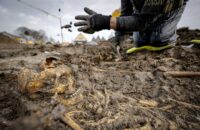 The grave was dug just outside the walls of the now-defunct Batestein Castle. Originally built in the 14th century nestled against the city walls of Vianen, much of the castle burned down in a fireworks show gone horribly wrong in 1696 and today all that remains is the Hof Gate and a few walls. The bodies were buried outside the gate on the slope of the city moat, a stretch which in the Middle Ages contained the castle’s stables.
The grave was dug just outside the walls of the now-defunct Batestein Castle. Originally built in the 14th century nestled against the city walls of Vianen, much of the castle burned down in a fireworks show gone horribly wrong in 1696 and today all that remains is the Hof Gate and a few walls. The bodies were buried outside the gate on the slope of the city moat, a stretch which in the Middle Ages contained the castle’s stables.
They were buried at the same time, so were probably victims of an infectious disease like plague or cholera, or of a war. If it’s the latter, it probably took place in the early 1480s during the struggle with the County of Holland for the secular territory of the Prince-Bishopric of Utrecht, a local offshoot of the Hook and Cod civil wars fought between Dutch nobles (the Hooks) and supporters of the Dukes of Burgundy/Holy Roman Emperor (the Cods). Batestein Castle was owned by the lords of Van Brederode who were big-time Hooks. The castle was betrayed by a Dutch Cod who opened the east gate and let in a raiding mob from Utrecht. A hundred years later there was another battle here in the Dutch Revolt against the Spanish Habsburgs.
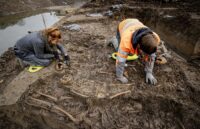 The excavation is ongoing and expected to last at least another four weeks. It depends on how deep the bodies go. They’ve dug down enough so far to find a skull 16 feet below the first find, and there are an unknown number of skeletons between them. The remains will be removed for osteological examination. Researchers will look for signs of blunt and sharp-force trauma or disease. The bones will be radiocarbon dated and DNA tested.
The excavation is ongoing and expected to last at least another four weeks. It depends on how deep the bodies go. They’ve dug down enough so far to find a skull 16 feet below the first find, and there are an unknown number of skeletons between them. The remains will be removed for osteological examination. Researchers will look for signs of blunt and sharp-force trauma or disease. The bones will be radiocarbon dated and DNA tested.
